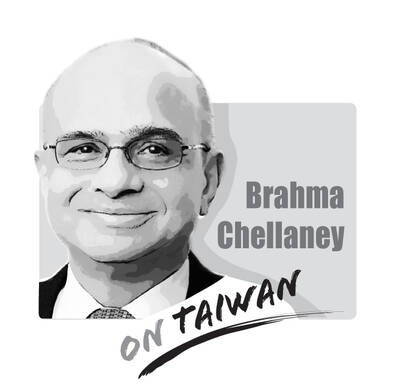The signing of the Regional Comprehensive Economic Partnership (RCEP) has panicked manufacturers in local traditional industries, especially makers of screws and fasteners, who fear they could lose their competitiveness if forced to pay higher tariffs than rivals from RCEP members.
The government has tried to assure local industries that the effects of the new pact would be moderate in the short term, considering its patchy coverage, and given that some sensitive industries are to be exempted from customs duty.
Taiwan already has agreements with 70 percent of RCEP members that reduce tariffs to zero, officials have said.
However, the tax agreements mostly cover electronic items, not steel or petrochemical products, or the screws used in the automotive and construction sectors, industry insiders have said.
Local screw and fastener manufacturers pay customs duties ranging from 5 to 30 percent for goods shipped to Southeast Asia, Taiwan Industrial Fasteners Institute chairman Tsai Tu-chin (蔡圖晉) told reporters on Sunday before attending a meeting with economic officials to discuss measures to deal with the new trade pact.
Taiwanese manufacturers have suffered a double blow from heavy import tariffs and the New Taiwan dollar’s volatility against the US dollar over the past few years, leading to a downtrend in production value, Tsai said, adding that this year the challenge would be even greater given the economic fallout from the COVID-19 pandemic.
The production value of screw and fastener makers is likely to reach just NT$110 billion (US$3.82 billion), he added.
The production value of local screw and fastener makers last year shrank almost 19 percent, from NT$176 billion in 2018 to NT$143 billion, the institute’s statistics showed.
As China is catching up with Taiwan in competing for a bigger slice of the Japanese market, the institute fears that the RCEP deal will put local manufacturers at a disadvantage, it told the Ministry of Economic Affairs (MOEA).
The RCEP’s members — the 10 ASEAN members plus South Korea, China, Japan, Australia and New Zealand — account for 30 percent of the global economy and US$2.3 trillion in goods, making it the world’s biggest trade bloc. The China-led bloc is set to strengthen Beijing’s role in Asia-Pacific regional trade and extend its influence in the region.
The pact is to take effect within the next two years, once enough participating countries ratify it. As much as 90 percent of goods exported by RCEP members would face zero tariffs, as soon as the pact takes effect or over a 10-year period.
Local screw and fastener makers face big trading challenges brought by the RCEP, considering their smaller scale in terms of paid-in capital and annual revenue than Taiwanese firms in other traditional industries such as the Formosa Group.
Most of them are unlisted, and rely primarily on bank loans and cash from operations to expand and invest in new production lines and products.
The MOEA has suggested that they increase their investment in research and development (R&D), shift production to higher-value products and invest in smart manufacturing facilities.
The government usually pays up to 40 percent of the R&D spending by local firms, but few traditional sector firms have made use of the subsidy, the ministry said. Such measures and suggestions would certainly help local firms enhance competitiveness, but they will take several years to realize, while the tariff barriers for RCEP members would fall as soon as the deal takes effect.
Taiwanese companies are counting on short-term relief measures from the government to help them minimize the fallout from the RCEP, as they focus on upgrading their technological capabilities to ensure long-term competitiveness.
Recently, China launched another diplomatic offensive against Taiwan, improperly linking its “one China principle” with UN General Assembly Resolution 2758 to constrain Taiwan’s diplomatic space. After Taiwan’s presidential election on Jan. 13, China persuaded Nauru to sever diplomatic ties with Taiwan. Nauru cited Resolution 2758 in its declaration of the diplomatic break. Subsequently, during the WHO Executive Board meeting that month, Beijing rallied countries including Venezuela, Zimbabwe, Belarus, Egypt, Nicaragua, Sri Lanka, Laos, Russia, Syria and Pakistan to reiterate the “one China principle” in their statements, and assert that “Resolution 2758 has settled the status of Taiwan” to hinder Taiwan’s
Singaporean Prime Minister Lee Hsien Loong’s (李顯龍) decision to step down after 19 years and hand power to his deputy, Lawrence Wong (黃循財), on May 15 was expected — though, perhaps, not so soon. Most political analysts had been eyeing an end-of-year handover, to ensure more time for Wong to study and shadow the role, ahead of general elections that must be called by November next year. Wong — who is currently both deputy prime minister and minister of finance — would need a combination of fresh ideas, wisdom and experience as he writes the nation’s next chapter. The world that
The past few months have seen tremendous strides in India’s journey to develop a vibrant semiconductor and electronics ecosystem. The nation’s established prowess in information technology (IT) has earned it much-needed revenue and prestige across the globe. Now, through the convergence of engineering talent, supportive government policies, an expanding market and technologically adaptive entrepreneurship, India is striving to become part of global electronics and semiconductor supply chains. Indian Prime Minister Narendra Modi’s Vision of “Make in India” and “Design in India” has been the guiding force behind the government’s incentive schemes that span skilling, design, fabrication, assembly, testing and packaging, and

Can US dialogue and cooperation with the communist dictatorship in Beijing help avert a Taiwan Strait crisis? Or is US President Joe Biden playing into Chinese President Xi Jinping’s (習近平) hands? With America preoccupied with the wars in Europe and the Middle East, Biden is seeking better relations with Xi’s regime. The goal is to responsibly manage US-China competition and prevent unintended conflict, thereby hoping to create greater space for the two countries to work together in areas where their interests align. The existing wars have already stretched US military resources thin, and the last thing Biden wants is yet another war.